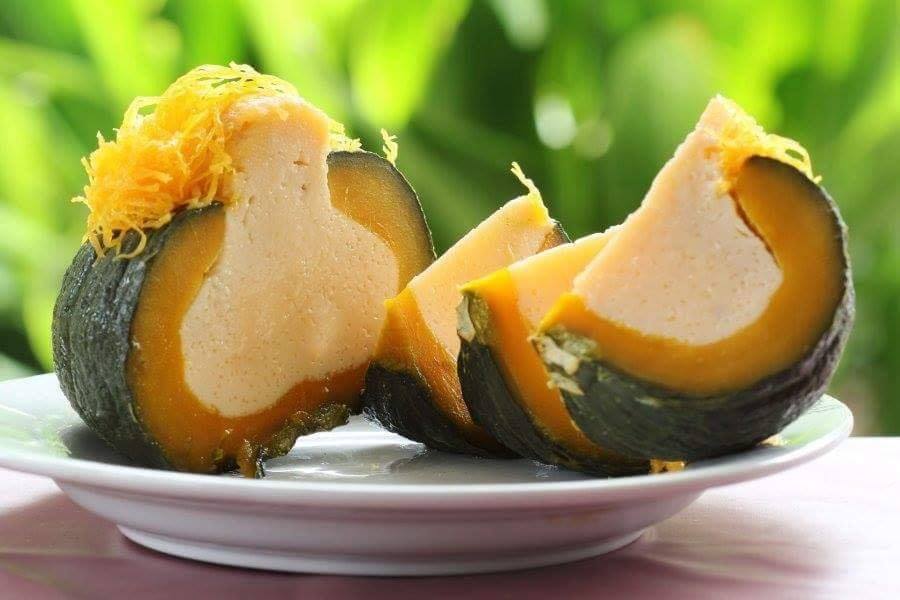Cambodian cuisine is renowned for its intricate flavors and harmonious blends of spices, and its desserts are no exception. From the enticing aroma of pandan leaves to the delightful creaminess of coconut milk, Cambodian desserts offer a unique and mouthwatering experience.
Cambodian desserts are a gateway to experiencing the heart and soul of this captivating cuisine. From traditional favorites to innovative creations, each dessert invites you to partake in a cultural journey through flavors, textures, and stories. So, whether you’re a curious foodie or an adventurous traveler, don’t miss the chance to try Cambodian desserts and discover the sweet magic that awaits your palate.
In this article, we delve into some of the best Cambodian desserts that capture the essence of this rich culinary heritage.
Savoring Sweet Traditions: Exploring the Best Cambodian Desserts
Let’s enjoy one sweet bite at a time:
1. Jek Ktiss (Cambodian Banana-Topica Pudding)
Jek Ktiss is a luscious Cambodian dessert that marries the sweetness of bananas with the creaminess of coconut milk. Slices of banana and topica (a type of cassava) are cooked in a rich coconut sauce, resulting in a velvety pudding that encapsulates the tropical flavors of Cambodia.
2. Lort Svet (Pandan Leaf Dessert)
Lort Svet is a visually striking dessert that showcases the vibrant green hues of pandan leaves. These leaves are blended to extract their essence, which is then used to flavor a jelly-like dessert made from agar agar. Lort Svet’s unique appearance is matched by its delicate pandan fragrance and mild sweetness.
3. Bobor Jadov (Black Eye Bean with Sticky Rice Dessert)
Jadov is a comforting dessert that features black eye beans and sticky rice, delicately flavored with coconut milk and palm sugar. The combination of tender beans, chewy rice, and the gentle sweetness of palm sugar makes Jadov a satisfying treat for any occasion.
4. Bobor Tnaot (Palm Fruit Dessert)
Bobor Tnaot is a delightful Cambodian dessert that celebrates the natural sweetness of palm fruits. The fruits are simmered in coconut milk and palm sugar, resulting in a creamy and tropical dessert that’s both satisfying and refreshing.
5. Bobor Lapov (Coconut Cream Pumpkin with Tapioca)
Bobor Lapov is a heartwarming dessert that combines the wholesome goodness of pumpkin with the comfort of tapioca pearls. Simmered in coconut cream and flavored with pandan leaves, this dessert is a warm embrace on a cool day.
You may check: Best Cambodian Foods You Must Try
6. Bobor Trav (Taro With Sticky Rice Dessert)
Bobor Trav is a harmony of textures, with tender taro chunks mingling with sticky rice in a creamy coconut sauce. This dessert showcases the contrast between the earthy sweetness of taro and the richness of coconut milk.
7. Bobor Sandek Khiev (Green Mung Bean Pudding)
Bobor Sandek Khiev is a soothing dessert made from green mung beans, slow-cooked to achieve a creamy consistency. This dessert’s simplicity allows the natural flavor of the mung beans to shine through, creating a comforting and nourishing treat.
8. Tav Sorn (Mung Bean Pudding With Coconut Milk)
Tav Sorn is a mung bean pudding that embodies the essence of Cambodian comfort food. The mung beans are cooked until tender, then blended with coconut milk and palm sugar to create a smooth and velvety dessert.
9. Banh Ja’neuk (Khmer Glutinous Rice Ball Dessert)
Banh Ja’neuk features glutinous rice balls swimming in a fragrant coconut milk broth. The rice balls are chewy and tender, while the coconut milk base adds a rich creaminess that makes every bite a delightful experience.
10. Sankhya Lapov (Khmer Pumpkin Custard)
Sankhya Lapov is a pumpkin custard dessert that captures the essence of comfort food. Made from pumpkin, coconut milk, and palm sugar, this velvety treat is often topped with a sprinkling of sesame seeds for added texture.
11. Bay Damnerb Sankya Durian (Durian And Sticky Rice)
For durian lovers, this dessert is a dream come true. Bay Damnerb Sankya Durian combines the unique flavor of durian with sticky rice and coconut milk, resulting in a distinctive and indulgent dessert.
You may check: Cambodian Rice: The Heart of Cambodian Cuisine
12. Pro Krong (Green Grass Jelly Dessert)
Pro Kong is a refreshing dessert featuring green grass jelly cubes suspended in sweet coconut milk. The contrast between the silky coconut milk and the slightly chewy grass jelly creates a delightful textural experience.
13. Khmer Jack fruit Jelly (Coconut Jelly Jackfruit Dessert)
Khmer Jack Fruit Jelly is a delightful combination of coconut jelly and the tropical sweetness of jackfruit. The dessert’s bright colors and fruity flavors make it a visually appealing and delicious treat.
14. Trorpae Kmav (Sweet Fermented Black Sticky Rice)
Trorpae Kmav is a unique dessert that showcases the flavors of fermented black sticky rice with freshly shredded coconut. This dish features a balance of sweet and slightly tangy notes, resulting from the fermentation process.
15. Trorpae Sar (Sweet Fermented White Sticky Rice)
Similarly, Trorpae Sar is made from sweet fermented white sticky rice. The fermentation imparts a complex flavor profile that elevates this dessert to a unique and satisfying level.
16. Bang Em Krab K’nor (Jack Fruit Seeds Dessert)
Bang Em Krab K’nor celebrates the often-overlooked jackfruit seeds. These seeds are made from mung bean, and then simmered in coconut milk and palm sugar, transforming them into a sweet and satisfying dessert.
17. Num Banh Duk (Khmer Pandan Cake Dessert)
Num Banh Duk is a vibrant green pandan cake dessert that not only delights the eyes but also tantalizes the taste buds. The pandan flavor, combined with coconut milk and palm sugar, creates a harmonious and memorable treat.
You may check: Best Drinks In Cambodia You Can Enjoy
What Makes Cambodian Desserts Special?
Cambodian desserts are a testament to the country’s rich cultural heritage and its deep connection to nature. These sweet treats go beyond mere indulgence; they encapsulate centuries-old traditions, creative ingenuity, and a profound appreciation for locally sourced ingredients. What truly makes Cambodian desserts special is the unique blend of flavors, textures, and cultural significance that they bring to the table.
Cultural Heritage and Tradition
Cambodian desserts are steeped in tradition, often tracing their roots back through generations. These desserts serve as a link to the past, preserving culinary practices that have been passed down within families and communities. Each bite carries the stories, memories, and values of Cambodian culture.
Use of Local Ingredients
One of the defining aspects of Cambodian desserts is their reliance on local ingredients. From fragrant pandan leaves to sweet palm sugar and tropical fruits like mangoes and jackfruit, Cambodian desserts celebrate the bounties of the land. This emphasis on local flavors not only enhances the taste but also reinforces a connection to the country’s agricultural heritage.
Harmonious Blending of Flavors
Cambodian desserts masterfully combine flavors to create harmonious compositions. The interplay of sweet, savory, nutty, and floral notes creates a symphony on the palate. The use of ingredients like coconut milk, black beans, and sticky rice results in a balanced fusion that surprises and delights.
Texture Play
The texture is key in Cambodian desserts, and this is where the artistry truly shines. The juxtaposition of chewy glutinous rice, creamy coconut milk, and crunchy toppings adds layers of sensory delight. Whether it’s the silky smoothness of coconut jelly or the satisfying bite of sticky rice, the textures elevate the overall experience.
Visual Appeal
Cambodian desserts are often visually stunning, presenting a feast for the eyes as well as the taste buds. The vibrant colors, intricate presentations, and meticulous attention to detail transform each dessert into an edible work of art, enhancing the overall enjoyment.
Symbolism and Ritual
Many Cambodian desserts hold symbolism and play a role in rituals and celebrations. These treats are often offered to ancestors during ceremonies or shared among loved ones during festive occasions. This connection between food and tradition adds a layer of reverence and significance to the desserts.
Sense of Community
Enjoying Cambodian desserts is often a communal experience. Families, friends, and neighbors come together to prepare, share, and savor these delicacies. The act of sharing desserts fosters a sense of togetherness, unity, and hospitality that’s deeply ingrained in Cambodian culture.
Preserving Cultural Identity
Cambodian desserts are not just about taste; they’re a vehicle for preserving cultural identity. As the world evolves, these desserts serve as a link to the past and a reminder of the values, stories, and rituals that define Cambodia’s unique heritage.
Final Thought
Cambodian desserts are a testament to the country’s dedication to preserving culinary traditions and celebrating the richness of its ingredients. These indulgent treats offer a glimpse into Cambodia’s history, culture, and flavors, taking taste buds on a journey through the unique and vibrant world of Cambodian cuisine. As you savor each spoonful of these desserts, you’re not just enjoying a delicious treat; you’re partaking in a culinary heritage that has stood the test of time.



